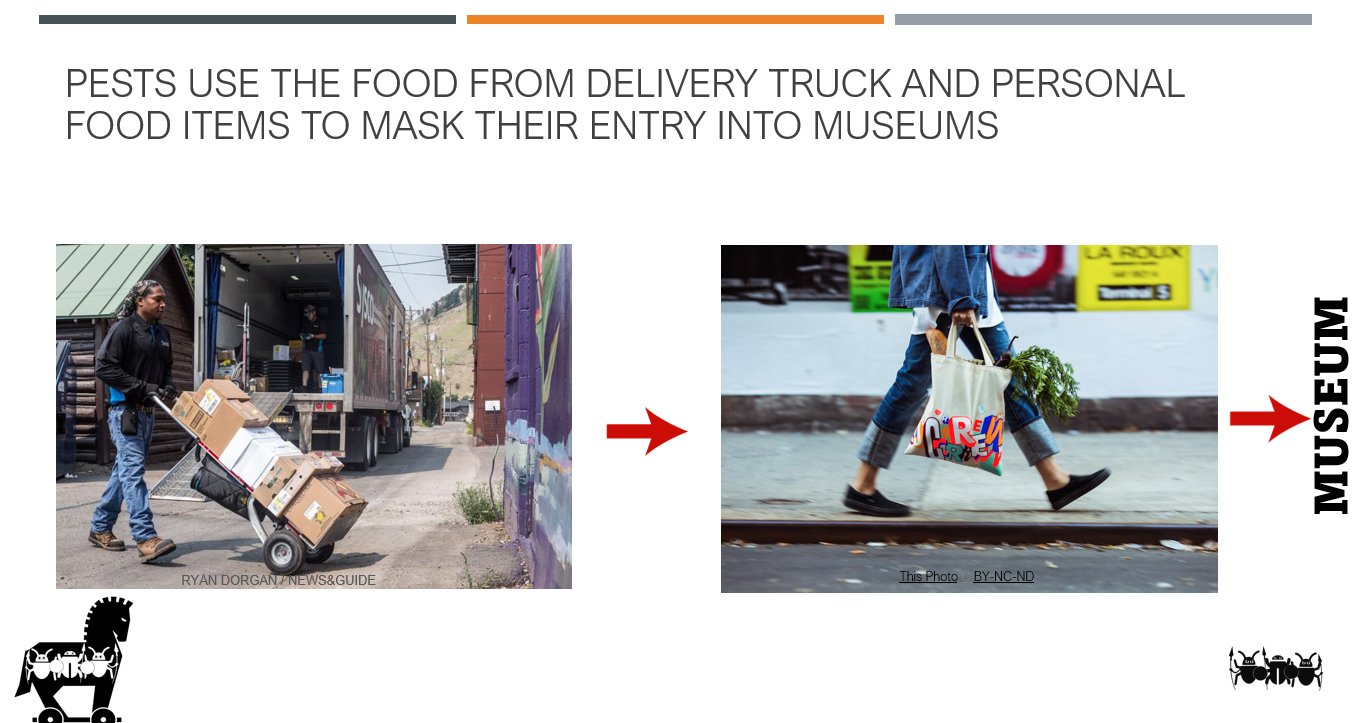From Cuisine to Collections – Restaurant and Food Sales inside Museums Can Introduce Pest Insects into Collections
By Patrick Kelley, BCE
Museums are sanctuaries of culture and history, housing priceless collections that convey the tale of our cultural history. While these institutions strive to provide an immersive experience for visitors, an unexpected threat lurks within the very spaces designed to enhance the museum-going experience: the integration of restaurants and food sales in nearly every museum to some degree.
Beyond the immediate gastronomic pleasures, the link between culinary delights and museum collections may inadvertently introduce a less savory element – museum-specific pest insects.
Food items entering a museum often become "Trojan Horses” that allow the entry of pests into museum collections
Museum cafes and restaurants have become integral components of the visitor experience, offering a chance to rejuvenate amidst exhibits and fostering a sense of community.
From a bottom-line standpoint, museum administrators count on the money generated from the food revenue to pay staff and keep the doors open to the public.
However, the presence of food in a museum creates an environment conducive to the presence of pests that can pose a threat to munchable artifacts. There is also a culture that exists within many museums where the museum staff can bring food in with them to eat during the day.
The day-to-day influx of human food is a common ‘Trojan Horse’ that allows the entry of pests into the museum.
The introduction of pest insects into museum collections is a genuine concern that museums must address. Common culinary pests, such as grain beetles, carpet beetles, silverfish, booklice, mice and cockroaches, can easily hitch a ride on incoming food supplies. Once inside the museum, these pests can find their way to collections, where they pose a significant risk to irreplaceable items.
Many common pests of food items can easily transfer over to become serious pests of museum objects
Organic Materials in Museum Collections
Museum collections often include items made of organic materials such as textiles, wood, and paper, which are particularly susceptible to damage by pests. Insects can burrow into collection materials, consume organic components, and leave behind irreparable damage. The impact of an infestation goes beyond the immediate visual damage, as the delicate process of restoration is both time-consuming and expensive. Many times, repairs are impossible.
Preserving the integrity of both culinary and cultural offerings within museums requires collaboration between food service providers and curatorial staff. Implementing shared awareness programs and training for all staff members can foster a collective responsibility for maintaining a pest-free environment.
IPM programs need someone to be in-charge and to make sure that due diligence is done in inspecting incoming kitchen and retail food as well as limiting the hidden stashes of staff food supplies in desk drawers.
As museums continue to evolve to meet the changing expectations of their visitors, the potential threats to collections must not be overlooked. Balancing the inclusion of culinary delights with the preservation of delicate artifacts is a daily dance that museums must master to ensure the longevity of our cultural heritage.
By understanding the connection between cuisine and collections, institutions can take proactive steps to safeguard their treasures and maintain the sanctity of these repositories of human history while allowing a savory snack between walking through the Bird and Reptile Gallery and the Human Origins Hall.
Related Insect and Pheromone Posts
Read more about insects and pheromones in these related posts:
Product of the Month - Red-Legged Ham Beetle Kit (IL-660)
Insect of the Month: Red-Legged Ham Beetle (Necrobia rufipes)
New Dirty Dozen Poster Now Available - Enhance Your Pest Management Efforts Today
Insects Limited, an Insect Pheromone Company
Insects Limited, Inc. researches, tests, develops, manufactures and distributes pheromones and trapping systems for insects in a global marketplace. The highly qualified staff also can assist with consultation, areas of expert witness, training presentations and grant writing.
Insects Limited, Inc. specializes in a unique niche of pest control that provides mainstream products and services to protect stored food, grain, museum collections, tobacco, timber and fiber worldwide. Please take some time to view these products and services in our web store.






